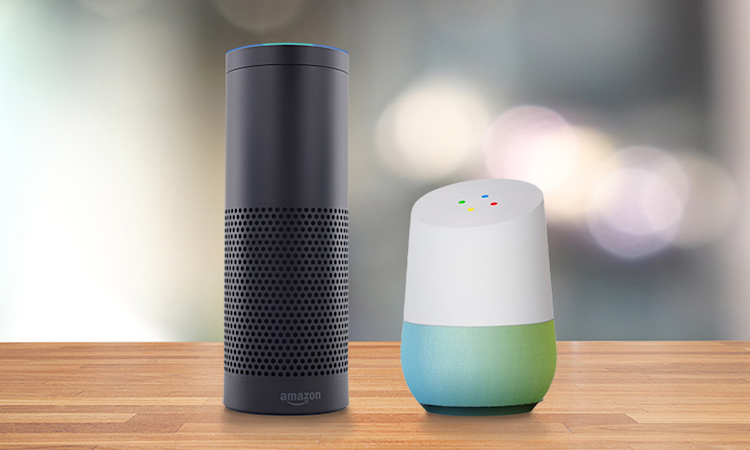The voice-first consumer market is rapidly changing. Stakeholders continue to announce new moves and product roadmaps. Integrations and partnerships are regularly being made. New entrants, seeking opportunity in the intensifying appeal of voice-enabled technologies, are placing their bets with their own offerings.
Both devices and applications are now on market—primarily in the personal assistant space—that embrace voice-first; that is, they feature an interface for which the primary input and output is voice.
Parks Associates tracks both instances in consumer reported adoption.
As the consumer voice-first market continues to grow its ecosystem, consumers face a widening array of choices available. A number of factors will lead to market shifts and accelerations in terms of adoption and sales.
• Consumer experience with first generation devices: UX is particularly important in the CE market, where repeat brand purchases are the norm. First-generation devices often have to tackle product issues from the introduction of new technology. Parks Associates Q1 2016 data reveals that 54% of consumers will buy another product of the same brand if no problems occur with the current device or service. Only 31% of product owners who experience two or more problems will buy another product of the same brand.
Companies must balance the race to establish early market share with the danger of prematurely releasing a voice-enabled device or application that is riddled with software issues. Samsung’s delay of Bixby on Galaxy S8 smartphones reiterates the challenge in launching a sophisticated voice-first application. This delay will be crucial for Bixby—not only will Samsung be rolling out the Galaxy S8 without Bixby, but with its rival Google Assistant taking its place. The smartphone will offer features of Bixby but no voice command capabilities—still a delayed, competitive, and market-ready launch of Bixby may be better than one that falls short of its competitors, even if it means losing valuable time with consumers.
Amazon Echo devices and Google Home have proven the appeal in voice assistant devices with their rapid success. Due to market reception, Amazon has already introduced its second-generation devices with the Echo Tap and Echo Dot. Google is reportedly already in development of its next-generation Home device. So, new entrants undoubtedly will be playing catch-up, but can also learn valuable lessons from first-movers’ roll-outs, design flaws, and user feedback.
• Additional purchases: Devices like the Amazon Dot have allowed for portability and the extension of voice assistants to multi-room experiences. Smaller form factors and lower price points entice consumers to add additional devices throughout the home. Amazon’s Echo Spatial Perception (ESP) update illustrates the anticipation in consumer’s building their ecosystem beyond just one smart speaker. With ESP, Amazon has programmed its Echo devices to respond to a user’s command only from the speaker that is closest to the user. Parks Associates finds that among smart speakers with voice-enabled personal assistant owners, over a quarter use two or more devices in their household. The impact of additional purchases on the growth and potential of this market is dramatic. If consumers embrace a multi-room voice-first approach, the unit sales projections for this category would increase multi-fold.
• New entrants: Whether integrating products with current market voice assistants or creating their own proprietary solutions, companies are entering the competitive fold seeking to capitalize on the momentum. Those that have integrated their products or services with third-party voice assistants have seen their efforts rewarded. Linkplay, for instance, a comprehensive audio solution provider, has integrated its speakers with Alexa and has found a 50-60% increase in sales from doing so. New entrants expand the products offerings available to consumers, can fill potential gaps in current market offerings, and can push the adoption curve further by approaching consumers’ needs in a different way.
Furthermore, industry giants, such as Samsung, who enter the market will be able to leverage their existing customer base. Consumers are inclined to use the voice assistant that is provided with the device they are using. For instance, in Q4 2016 Parks Associates found that 50% of iPhone users use Siri. By comparison, only 22 percent of Windows phone users use Cortana.
• Expanding partnerships: Partnerships will lead to greater adoption by expanding the reach and utility of voice assistant devices. Google Home recently announced partnerships with over 10 different smart home products, effectively expanding its footprint in the smart home. Amazon Alexa currently has 337 smart home related skills. As partnerships grow and the list of compatible products expand, voice assistant devices will increase in the potential value propositions they are able to offer. Allowing third-party manufacturers to integrate voice assistants into their product designs pushes adoption beyond the form factor of a smart speaker. Consumers will be able to summon their kitchen appliances to their connected car with voice commands.
For more information on voice technologies, Parks Associates’ industry report, Voice Assistants and Technologies: Ecosystem and Market Leaders, assesses leading personal assistant devices, analyzes business models, evaluates the impact of voice control on various market segments, presents consumer preferences and usage for voice interfaces, and forecasts sales of smart speakers with personal assistants through 2021.
Further Reading:


